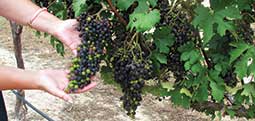| Current Issue | Past Issues | Subscribe | Ag Homepage |

Standing Up to Roundup®
in Alabama Fields
by
It’s becoming an all-too-common occurrence in Alabama agriculture: another weed added to the list of aggressive, undesirable weeds that can hold their own against the broad-spectrum herbicide glyphosate, best known by the brand name Roundup®. In truth, herbicide-resistant weeds are here, and the problem is getting worse.
The four resistant species that have been identified in Alabama fields to date are Palmer amaranth, or pigweed, along with horseweed, common ragweed and goosegrass.
Monsanto introduced Roundup in the 1970s, and in the decades since, farmers, researchers and turfgrass managers have become heavily reliant on the herbicide. Too reliant, Auburn University weed scientist Scott McElroy says.
“We’ve learned a lot about the development of herbicide-resistant weeds and especially about how management practices influence development,” says McElroy, professor in the Department of Crop, Soil and Environmental Sciences. “One of the specific things the public needs to understand about this problem is that it is a natural-selection phenomenon that was brought on by the continuous use of Roundup.”
Gradually, some of the troublesome weeds farmers had long kept in check with Roundup became resistant, and the weeds that survived the herbicide the longest produced the most seeds. Repeat that process year after year, and sooner or later, the strongest weeds weeded out the weakest weeds. Say that five times fast.
Pigweed can grow to more than 6 feet in height and can carry a million-plus seeds. The seeds of herbicide-resistant pigweed continue the trait. It’s easy to see the snowball effect taking over and running even the most disciplined farmer off of his or her land, McElroy says.
Glyphosate-resistant weeds are not just an Alabama problem. Twenty-two states, largely in the South and Midwest regions, have reported cases.
Charles Burmester, an Extension agronomist at Auburn’s Tennessee Valley Research and Extension Center in Belle Mina, has spent time investigating the origin of the glyphosate resistance and its rapid spread.
“We found that most glyphosate-resistant weed cases began in southern Georgia and Arkansas, but we didn’t know how they spread to multiple states,” Burmester says. “Our home state was especially difficult to figure out, since our terrain differs a little bit from other heavily agricultural states.”
While most seeds are dispersed by birds and wind, Burmester says Alabama’s forests and high elevation in the north actually prevent the spread of seeds in those fashions. Used farm equipment wound up being the missing piece of the puzzle.
“Let’s say you’re a farmer, and you just purchased a used tractor from another farmer from another state, and he happened to have glyphosate-resistant weeds on his land,” Burmester says. “If you lack the discipline to clean the tractor properly, many of the seeds lodged underneath it are going to rattle out and into your fields once you start to use it.”
Discipline is the key message Auburn’s team of researchers and Extension specialists are carrying around the state. Since last year, they’ve been traveling to communities to educate farmers on the discipline it will take to slow the spread of glyphosate-resistant weeds.
Andrew Price, a weed scientist with USDA’s National Soil Dynamics Lab in Auburn, says herbicide-resistant weeds pose one of the most significant threats to soil conservation in the 80-year history of the Natural Resources Conservation Service.
“We have a situation where farmers need to maintain a standard of crop yield, but herbicides aren’t as affective as before,” says Price, who also is an Auburn crop, soil and environmental sciences affiliate associate professor. “If the only way you can kill the plant is by physically pulling it out of the ground or burying it, then farmers will adopt more conventional tillage into their rows instead of conservation tillage.”
Conventional tillage, in its simplest form, kills weeds by a combination of severing shoots from roots, uprooting or burying the plant underneath the surface. But those traditional practices also lead to increased soil erosion, loss of soil moisture and structure and higher expenses with equipment, operations and energy.
“If and when we do find a better solution to herbicide-resistant weeds, farmers will need to implement more diversity into their farming, which takes a lot of discipline,” Price says. “We have all failed, in a way, to preach more diversity in herbicides for crops, and now we need to move forward with diversity in every aspect of farming.”









Connect With Us!